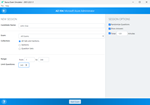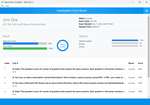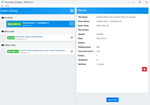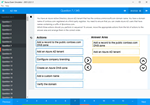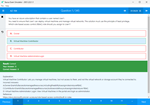Download Upgrading Your Skills to MCSA: Windows Server 2016.70-743.PracticeTest.2018-05-17.19q.tqb
| Vendor: | Microsoft |
| Exam Code: | 70-743 |
| Exam Name: | Upgrading Your Skills to MCSA: Windows Server 2016 |
| Date: | May 17, 2018 |
| File Size: | 760 KB |
How to open TQB files?
Files with TQB (Taurus Question Bank) extension can be opened by Taurus Exam Studio.
Purchase
Coupon: TAURUSSIM_20OFF
Discount: 20%
Demo Questions
Question 1
You have a Hyper-V host named Server1 that runs Windows Server 2016.
The installation source files for Windows Server 2016 are located in D:\Source.
You need to create a Nano Server image.
Which cmdlets should you run? To answer, drag the appropriate cmdlets to the correct targets. Each cmdlet may be used once, more than once, or not at all. You may need to drag the split bat between panes or scroll to view content.
Correct answer: To work with this question, an Exam Simulator is required.
Explanation:
Step 1: Import ModuleImport-Module .\NanoServerImageGenerator.psm1 Step 2: New New-NanoServerImageCreate Nano Server Image VHDX New-NanoServerImage -MediaPath .\Files -BasePath .\Base -TargetPath .\Images\NanoVMGA.vhdx References: https://technet.microsoft.com/en-us/windows-server-docs/get-started/deploy-nano-server Step 1: Import Module
Import-Module .\NanoServerImageGenerator.psm1
Step 2: New New-NanoServerImage
Create Nano Server Image VHDX
New-NanoServerImage -MediaPath .\Files -BasePath .\Base -TargetPath .\Images\NanoVMGA.vhdx
References: https://technet.microsoft.com/en-us/windows-server-docs/get-started/deploy-nano-server
Question 2
You have a network that contains several servers that run Windows Server 2016.
You need to use Desired State Configuration (DSC) to configure the servers to meet the following requirements:
- Install the Web Server server role
- Start the World Wide Web Publishing service
How should you configure the DSC recourses? To answer, drag the appropriate values to the correct locations. Each value may be used once, more than once, or not at all. You may need to drag the split bar between panes or scroll to view content.
Correct answer: To work with this question, an Exam Simulator is required.
Explanation:
Box 1: WindowsFeatureThe WindowsFeature resource in Windows PowerShell Desired State Configuration (DSC) provides a mechanism to ensure that roles and features are added or removed on a target node. Box 2: PresentThe Ensure Property indicates if the role or feature is added. To ensure that the role or feature is added, set this property to "Present" To ensure that the role or feature is removed, set the property to "Absent". Example:WindowsFeature RoleExample { Ensure = "Present" # Alternatively, to ensure the role is uninstalled, set Ensure to "Absent" Name = "Web-Server"# Use the Name property from Get-WindowsFeature } Box 3: ServiceThe Service resource in Windows PowerShell Desired State Configuration (DSC) provides a mechanism to manage services on the target node. Box 4: RunningThe State property indicates the state, either Running or Stopped, you want to ensure for the service. References:https://msdn.microsoft.com/en-us/powershell/dsc/windowsfeatureresourcehttps://msdn.microsoft.com/en-us/powershell/dsc/serviceresource Box 1: WindowsFeature
The WindowsFeature resource in Windows PowerShell Desired State Configuration (DSC) provides a mechanism to ensure that roles and features are added or removed on a target node.
Box 2: Present
The Ensure Property indicates if the role or feature is added. To ensure that the role or feature is added, set this property to "Present" To ensure that the role or feature is removed, set the property to "Absent".
Example:
WindowsFeature RoleExample
{
Ensure = "Present"
# Alternatively, to ensure the role is uninstalled, set Ensure to "Absent"
Name = "Web-Server"# Use the Name property from Get-WindowsFeature
}
Box 3: Service
The Service resource in Windows PowerShell Desired State Configuration (DSC) provides a mechanism to manage services on the target node.
Box 4: Running
The State property indicates the state, either Running or Stopped, you want to ensure for the service.
References:
https://msdn.microsoft.com/en-us/powershell/dsc/windowsfeatureresource
https://msdn.microsoft.com/en-us/powershell/dsc/serviceresource
Question 3
You deploy a Hyper-V server named Server1 in an isolated test environment. The test environment is prevented from accessing the Internet. Server1 runs the Datacenter edition of Windows Server 2016.
You plan to deploy the following guest virtual machines on the server:

Which activation model should you use for the virtual machines?
- Multiple Activation Key (MAK)
- Key Management Service (KMS)
- Original Equipment Manufacturer (OEM) key
- Automatic Virtual Machine Activation (AVMA)
Correct answer: D
Explanation:
On virtualization servers that are activated using Volume Licensing or OEM licensing, AVMA offers several benefits. Server datacenter managers can use AVMA to do the following:Activate virtual machines in remote locations Activate virtual machines with or without an internet connection Track virtual machine usage and licenses from the virtualization server, without requiring any access rights on the virtualized systems Note: AVMA requires a Microsoft Virtualization Server running Windows Server 2012 R2 Datacenter or Windows Server 2016 Datacenter. On virtualization servers that are activated using Volume Licensing or OEM licensing, AVMA offers several benefits.
Server datacenter managers can use AVMA to do the following:
- Activate virtual machines in remote locations
- Activate virtual machines with or without an internet connection
- Track virtual machine usage and licenses from the virtualization server, without requiring any access rights on the virtualized systems
Note: AVMA requires a Microsoft Virtualization Server running Windows Server 2012 R2 Datacenter or Windows Server 2016 Datacenter.
Question 4
Active Directory Recycle Bin is enabled. You discover that a support technician accidentally removed 100 users from an Active Directory group named Group1 an hour ago. You need to restore the membership of Group1.
What should you do?
- Perform tombstone reanimation.
- Export and import data by using Dsamain.
- Perform a non-authoritative restore.
- Recover the items by using Active Directory Recycle Bin.
Correct answer: B
Explanation:
A group has been modified. Nothing has been deleted. Therefore, answers A and D will not work. Answer C would work if it was an authoritative restore, but not a non-authoritative restore. The solution is to recover an earlier copy of the group from a backup or active directory snapshot by using Dsamain. References:https://technet.microsoft.com/en-us/library/cc772168(v=ws.11).aspx https://www.briefmenow.org/microsoft/you-need-to-restore-the-membership-of-group1-15/ A group has been modified. Nothing has been deleted. Therefore, answers A and D will not work. Answer C would work if it was an authoritative restore, but not a non-authoritative restore.
The solution is to recover an earlier copy of the group from a backup or active directory snapshot by using Dsamain.
References:
https://technet.microsoft.com/en-us/library/cc772168(v=ws.11).aspx https://www.briefmenow.org/microsoft/you-need-to-restore-the-membership-of-group1-15/
Question 5
Note: This question is part of a series of questions that present the same scenario. Each question in the series contains a unique solution. Determine whether the solution meets the stated goals.
In this section, you’ll see one or more sets of questions with the same scenario and problem. Each question presents a unique solution to the problem, and you must determine whether the solution meets the stated goals. Any of the solutions might solve the problem. It is also possible that none of the solutions solve the problem.
Once you answer a question in this section, you will NOT be able to return to it. As a result, these questions will not appear in the review screen.
Your network contains an Active Directory domain named contoso.com. The domain contains a DNS server named Server1. All client computers run Windows 10.
On Server1, you have the following zone configuration.

You need to prevent Server1 from resolving queries from DNS clients located on Subnet4. Server1 must resolve queries from all other DNS clients.
Solution: From windows PowerShell on Server1, you run the Add-DnsServerTrustAnchor cmdlet.
Does this meet the goal?
- Yes
- No
Correct answer: B
Explanation:
The Add-DnsServerTrustAnchor command adds a trust anchor to a DNS server. A trust anchor (or trust “point”) is a public cryptographic key for a signed zone. Trust anchors must be configured on every nonauthoritative DNS server that will attempt to validate DNS data. Trust Anchors have no direct relation to DSSEC validation. References:https://docs.microsoft.com/en-us/powershell/module/dnsserver/add-dnsservertrustanchor?view=win10-pshttps://technet.microsoft.com/en-us/library/dn593672(v=ws.11).aspx The Add-DnsServerTrustAnchor command adds a trust anchor to a DNS server. A trust anchor (or trust “point”) is a public cryptographic key for a signed zone. Trust anchors must be configured on every nonauthoritative DNS server that will attempt to validate DNS data. Trust Anchors have no direct relation to DSSEC validation.
References:
https://docs.microsoft.com/en-us/powershell/module/dnsserver/add-dnsservertrustanchor?view=win10-ps
https://technet.microsoft.com/en-us/library/dn593672(v=ws.11).aspx
Question 6
Your network contains an Active Directory domain named contoso.com. The domain contains a DNS server named Server1. All client computers run Windows 10.
On Server1, you have the following zone configuration

You need to prevent Server1 from resolving queries from DNS clients located on Subnet4.
Server1 must resolve queries from all other DNS clients.
Solution: From Windows PowerShell on Server1, you run the Export-DnsServerDnsSecPublicKey cmdlet.
Does this meet the goal?
- Yes
- No
Correct answer: B
Explanation:
Example: Export a trust anchor to a file shareThis command exports the trust anchor (DS record) for Contoso.com to a file share. A DNS administrator runs this command from the DNS server that hosts the zone Contoso.com and specifies that the zone signing key uses the SHA-1 algorithm to create the DS record. PS C:\> Export-DnsServerDnsSecPublicKey -ComputerName "DNSDC1.Contoso.com" -ZoneName "Contoso.com" -Path "\\MyDNSKeyShare\keys" -PassThru -DigestType "Sha1" Example: Export a trust anchor to a file share
This command exports the trust anchor (DS record) for Contoso.com to a file share. A DNS administrator runs this command from the DNS server that hosts the zone Contoso.com and specifies that the zone signing key uses the SHA-1 algorithm to create the DS record.
PS C:\> Export-DnsServerDnsSecPublicKey -ComputerName "DNSDC1.Contoso.com" -ZoneName "Contoso.com" -Path "\\MyDNSKeyShare\keys" -PassThru -DigestType "Sha1"
Question 7
Your Network contains one Active Directory domain named contoso.com.
You pilot DirectAccess on the network.
During the pilot deployment, you enable DirectAccess only for a group Contoso\Test Computers.
Once the pilot is complete, you need to enable DirectAccess for all the client computers in the domain.
What should you do?
- From Windows PowerShell, run the Set-DAClient cmdlet.
- From Windows PowerShell, run the Set-DirectAccess cmdlet.
- From Active Directory Users and Computers, modify the membership of the Windows Authorization Access Group.
- From Group Policy Management, modify the security filtering of an object named Direct Access Client Setting Group Policy.
Correct answer: D
Question 8
You have a server named Server1.
You enable BitLocker Drive Encryption (BitLocker) on Server1.
You need to change the password for the Trusted Platform Module (TPM) chip.
What should you run on Server1?
- Initialize-Tpm
- Import-TpmOwnerAuth
- repair-bde.exe
- bdehdcfg-exe
Correct answer: B
Question 9
You have two servers named Server1 and Server2. A firewall exists between Server1 and Server2.
Both servers run Windows Server Update Services (WSUS). Server1 downloads updates from Microsoft update.
Server2 must synchronize updates from Server1.
Which port should to open on the firewall?
- 80
- 443
- 3389
- 8530
Correct answer: D
Explanation:
On WSUS 6.2 and later (at least Windows Server 2012), port 8530 for HTTP and 8531 for HTTPS References: https://technet.microsoft.com/en-us/library/hh852346(v=ws.11).aspx On WSUS 6.2 and later (at least Windows Server 2012), port 8530 for HTTP and 8531 for HTTPS
References: https://technet.microsoft.com/en-us/library/hh852346(v=ws.11).aspx
Question 10
Note: This question is part of a series of questions that present the same scenario. Each question in the series contains a unique solution that might meet the stated goals. Some question sets might have more than one correct solution, while others might not have a correct solution.
After you answer a question in this section, you will NOT be able to return to it. As a result, these questions will not appear in the review screen.
Your network contains an Active Directory forest named contoso.com.
You need to identify which server is the schema master.
Solution: You open Active Directory Users and Computers, right-click contoso.com in the console tree, and then click Operations Master.
Does this meet the goal?
- Yes
- No
Correct answer: B
Explanation:
This solution only shows the domain FSMO roles, not the forest FSMO roles. References: https://blogs.technet.microsoft.com/mempson/2007/11/08/how-to-find-out-who-has-your-fsmo-roles/ This solution only shows the domain FSMO roles, not the forest FSMO roles.
References: https://blogs.technet.microsoft.com/mempson/2007/11/08/how-to-find-out-who-has-your-fsmo-roles/
HOW TO OPEN VCE FILES
Use VCE Exam Simulator to open VCE files

HOW TO OPEN VCEX FILES
Use ProfExam Simulator to open VCEX files


ProfExam at a 20% markdown
You have the opportunity to purchase ProfExam at a 20% reduced price
Get Now!